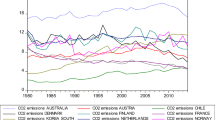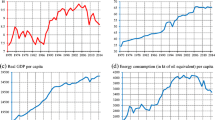Abstract
This study investigates the causality and long-term trend concerning Japan’s industrial production and carbon dioxide (CO2) emissions for the period 1990–2015 using the techniques of vector error correction (VEC) and Granger causality test. The results do not support the existence of Granger causality between Japan’s industrial production and CO2 emissions in any direction. However, the VEC estimation reveals that an increase in Japan’s industrial production by 1% is associated with a 0.08% increase in the country’s CO2 emission. It also reveals that any disequilibrium between Japan’s industrial production and CO2 emission could take about 0.7 quarters for half of the error to be corrected for. The adjustment rate for Japan’s industrial production is found to be positive but is quite slow at the rate of 0.08% per year. This suggests that the country’s industrial sector is expected to implement stricter environmental regulations in the future.


Similar content being viewed by others
References
Alvarez, I.G.: Impact of CO2 emission variation on firm performance. Bus. Strategy Environ. 21(7), 435–454 (2012)
Boiral, O., Henri, J.F., Talbot, D.: Modelling the impacts of corporate commitment on climate change. Bus. Strategy Environ. 21(8), 495–516 (2012)
Chang, Y.F., Lin, S.J.: Structural decomposition of industrial CO2 emission in Taiwan: an input-output approach. Energy Policy 26(1), 5–12 (1998)
Chang, T.C., Lin, S.J.: Grey relation analysis of carbon dioxide emissions from industrial production and energy uses in Taiwan. J. Environ. Manag. 56(4), 247–257 (1999)
Committee on Climate Change: CO2 emissions dropped in 2009. http://www.lowcarboneconomy.com/profile/the_low_carbon_economy_ltd/_low_carbon_blog/co2_emissions_dropped_in_2009/10196 (2010). Accessed 10 Nov 2016
Fujii, H., Managi, S.: Optimal production resource reallocation for CO2 emissions reduction in manufacturing sectors. Glob. Environ. Change 35(2015), 505–513 (2015)
Fujii, H., Iwata, K., Kaneko, S., Managi, S.: Corporate environmental and economic performance of Japanese manufacturing firms: empirical study for sustainable development. Bus. Strategy Environ. 22(3), 187–201 (2013)
Fujii, H., Assaf, A., Managi, S., Matousek, R.: Did the financial crisis affect environmental efficiency? Evidence from the Japanese manufacturing sector. Environ. Econ. Policy Stud. 18(2), 159–168 (2016)
Haddock-Fraser, J.E., Tourelle, M.: Corporate motivations for environmental sustainable development: exploring the role of consumers in stakeholder engagement. Bus. Strategy Environ. 19(8), 527–542 (2010)
Haeussler, F., Paul, R.: Introductory mathematical analysis for business, economics and the life and social sciences, 8th edn. Prentice Hall, Upper Saddle River (1996)
Huang, J., Nagasaka, K.: The trend of greenhouse gas emission for Japan large emitting industries under Kyoto protocol. Paper presented at the 2nd International Conference on Environmental Engineering and Applications, Shanghai, China, 19–21 August (2011)
International Energy Agency: Tracking industrial energy efficiency and CO2 emissions. http://www.iea.org/w/bookshop/add.aspx?id=298 (2007). Accessed 10 Nov 2016
Kiko Network: Greenhouse gas emissions in Japan—analysis of first data reported (FY2006) from emissions accounting, reporting and disclosure system for large emitters under Japan’s “the law concerning the protection of the measures to cope with global warming”. http://www.kikonet.org (2008). Accessed 11 March 2017
Kumar, S., Fujii, H., Managi, S.: Substitute or complement? Assessing renewable and non-renewable energy in OECD countries. Appl. Econ. 47(14), 1438–1459 (2015)
Lee, S.Y.: Corporate carbon strategies in responding to climate change. Bus. Strategy Environ. 21(1), 33–48 (2012)
Lim, H.J., Yoo, S.H., Kwak, S.J.: Industrial CO2 emissions from energy use in Korea: a structural decomposition analysis. Energy Policy 37(2), 686–698 (2009)
MacKinnon, J.G.: Numerical distribution functions for unit root and co-integration tests. J. Appl. Econom. 11(6), 601–618 (1996)
Martin, N., Rice, J.: Analysing emission intensive firms as regulatory stakeholders: a role for adaptable business strategy. Bus. Strategy Environ. 19(1), 64–75 (2010)
Ministry of the Environment: Kyoto protocol target achievement plan. Ministry of the Environment, Government of Japan, Tokyo (2008)
Ministry of the Environment: National greenhouse gas inventory report of Japan. Ministry of the Environment, Government of Japan, Tokyo (2011)
Murad, M.W., Abdullah, A., Boyle, S., Amaro, C.: Forecasting carbon emission and industrial production using VECM: the case of Bangladesh. J. Dev. Areas 49(6), 75–88 (2015). (Special Issue)
Newey, W.K., West, K.D.: Automatic lag selection in covariance matrix estimation. Rev. Econ. Stud. 61, 631–653 (1994)
Ogawa, J.: Revised Kyoto Target Achievement Plan—Overview and History of Revision. Ministry of the Environment, Government Japan, Tokyo (2008)
Sariannidis, N., Zafeiriou, E., Giannarakis, G., Arabatzis, G.: CO2 emissions and financial performance of socially responsible firms: an empirical survey. Bus. Strategy Environ. 22(2), 109–120 (2013)
Singh, T.: EU CO2 emissions dropped by 11% in 2009. http://www.euinfrastructure.com/news/eu-c02-emissions-drop/ (2010). Accessed 18 June 2016
Sprengel, D.C., Busch, T.: Stakeholder engagement and environmental strategy—the case of climate change. Bus. Strategy Environ. 20(6), 351–364 (2011)
UNdata: UNdata—a world of information. http://data.un.org/Default.aspx (2016). Accessed 23 May 2016
United States Department of Energy: Manufacturing consumption of energy 2002. Department of Energy, Government of the United States of America, Washington (2002)
United States Department of Energy: Annual energy review 2004. Department of Energy, Government of the United States of America, Washington (2005)
United States Environmental Protection Agency: Human-related sources and sinks of carbon dioxide. http://www.epa.gov/climatechange/emissions/co2_human.html (2011). Accessed 10 Nov 2016
Weinhofer, G., Hoffmann, V.H.: Mitigating climate change—how do corporate strategies differ? Bus. Strategy Environ. 19(2), 77–89 (2010)
Yagi, M., Fujii, H., Hoang, V., Managi, S.: Environmental efficiency of energy, materials, and emissions. J. Environ. Manag. 161(2015), 206–218 (2015)
Author information
Authors and Affiliations
Corresponding author
Rights and permissions
About this article
Cite this article
Murad, M.W., Alam, M.M. & Islam, M.M. Dynamics of Japan’s industrial production and carbon emissions: causality, long-term trend and implications. Lett Spat Resour Sci 11, 127–139 (2018). https://doi.org/10.1007/s12076-018-0205-6
Received:
Accepted:
Published:
Issue Date:
DOI: https://doi.org/10.1007/s12076-018-0205-6




